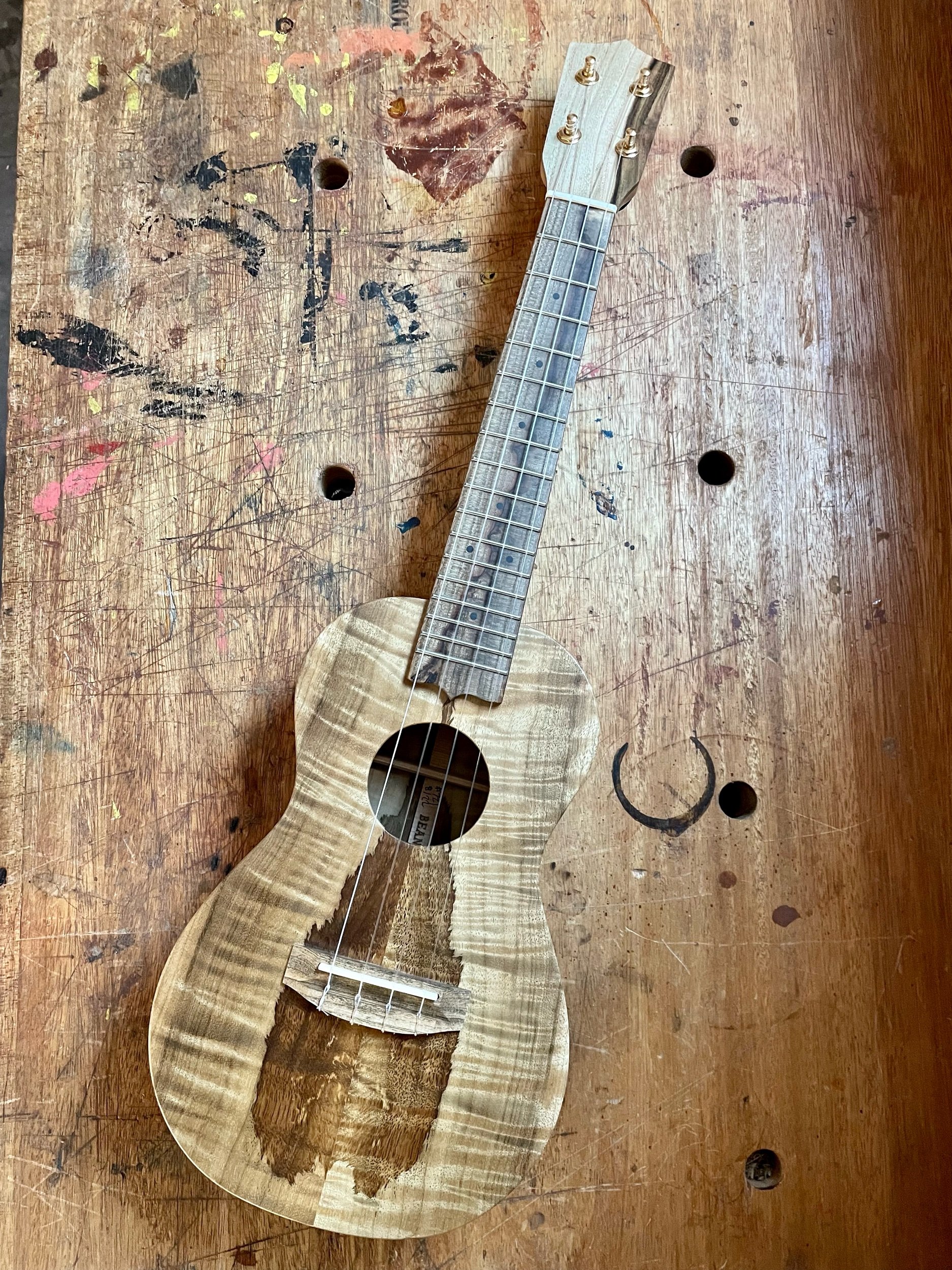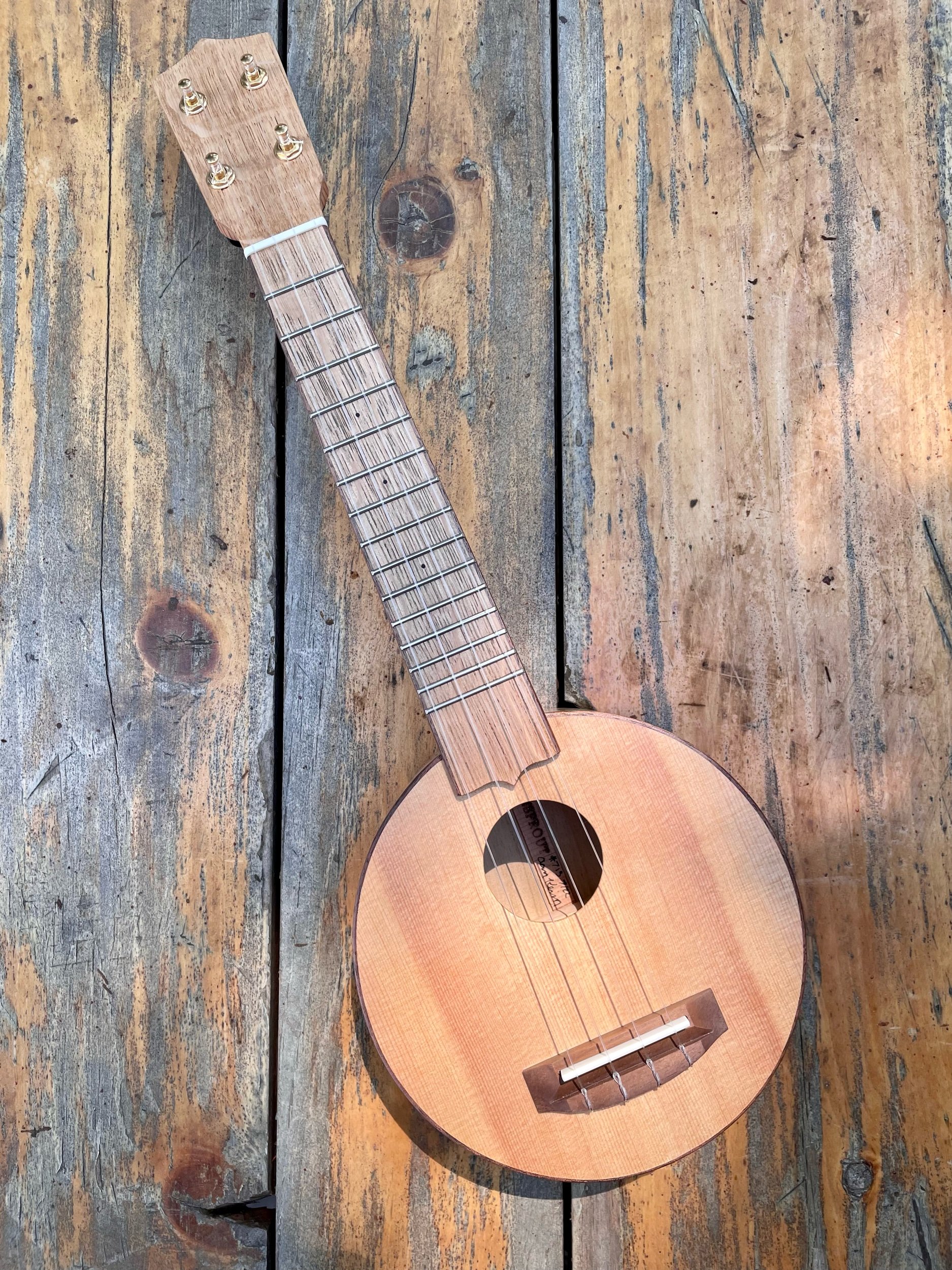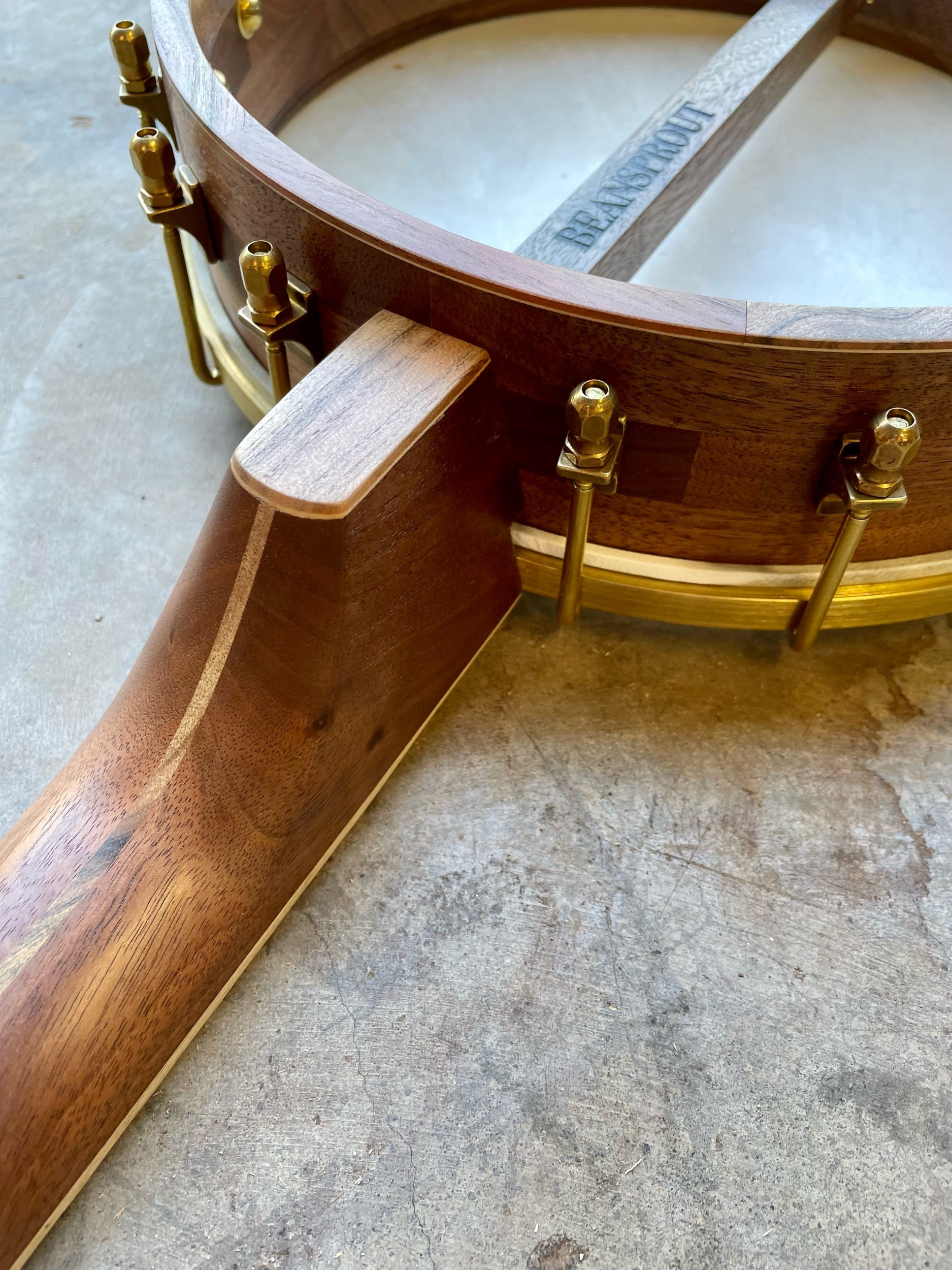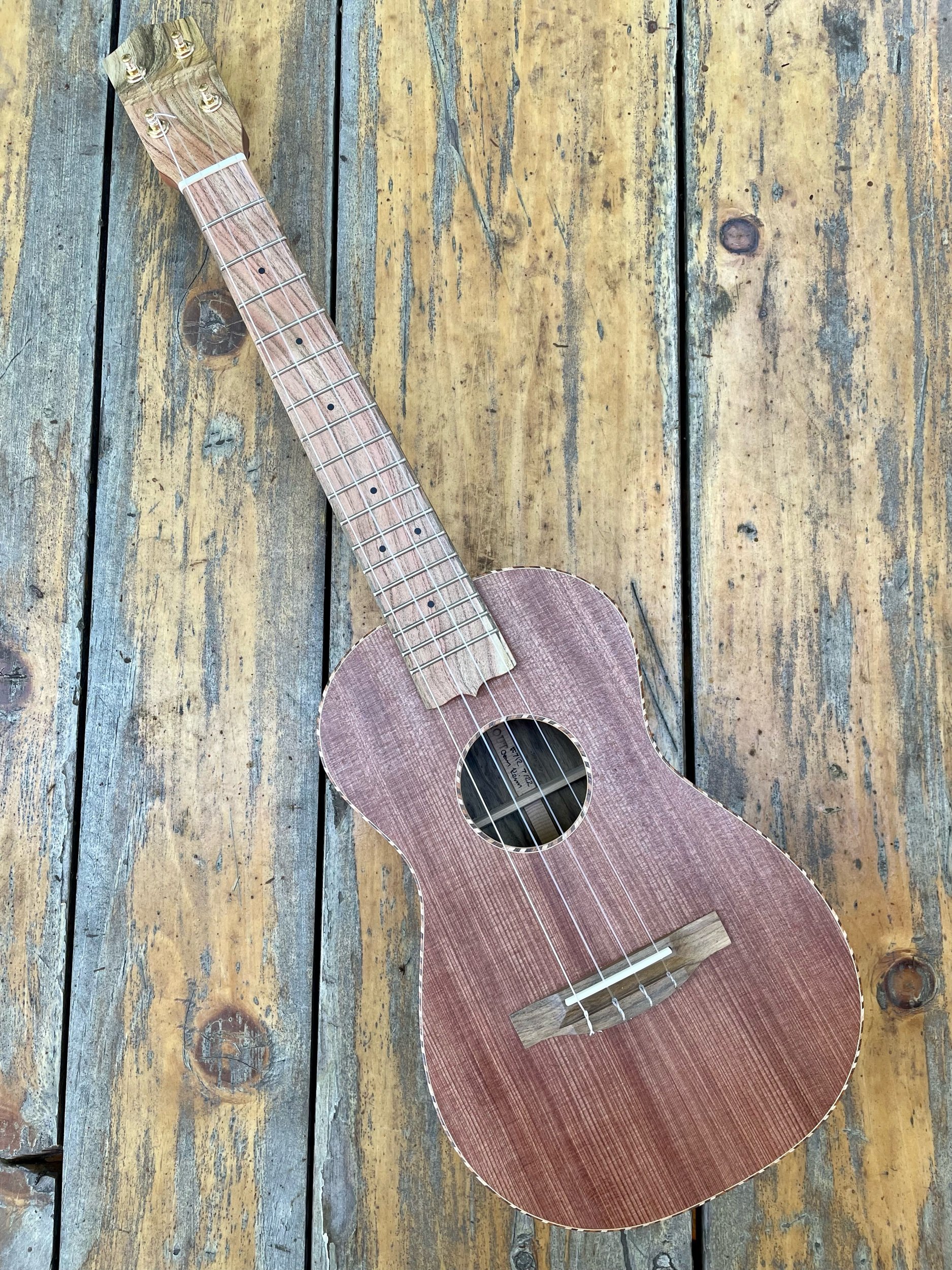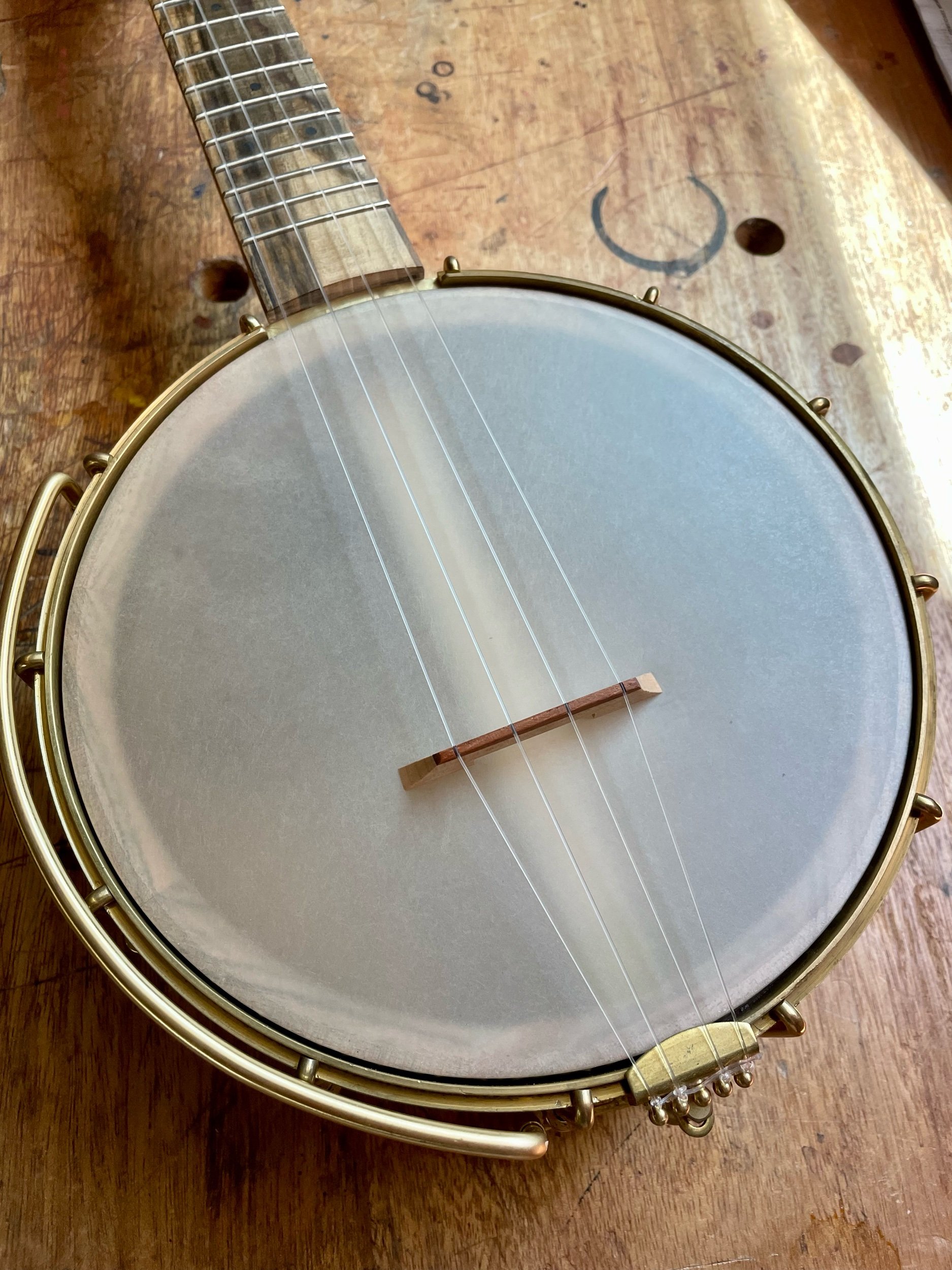Built for the auction at Tunes in the Dunes in September, to benefit Camp Westwind. Spruce and Maple from Westwind, Fir and Cherry scraps from the Carpenter Ant Stash in Portland and shop made rope binding.
#725- Maple and Jatoba Short Scale Five String Banjo
I’m not sure what to call this “model,” but it’s proved popular. It’s a basic five string banjo based off my personal instrument, built from whatever woods are on hand and then stained to match. I usually use a maple rim, in this case also a maple neck and Jatoba (Brazilian Cherry) everything else. The head is stained with walnut shells from our yard, the hardware is darkened and it has a K&K pickup, ready for the stage. It has a bright tone, but a lot of depth and richness as well, its on its way to Norway!
#728- Myrtle and Oak Scout Banjo Ukulele
I have been thinking about making some banjos with the same philosophy as my Scout ukuleles: lighter weight, humble designs, cheerful tone and made from whatever scraps are floating through the shop. The main thing that has been holding me back is producing thin, lightweight, laminated rims. These are made much differently than my normal block rims, they are steamed, bent and glued together from two oak layers. I was going for an old timey, chipper tone and it worked. I also learned a lot about steam bending rims and look forward to producing more.
I paired this rim with a Myrtle neck, oak fretboard and some walnut trim. It has less brass hardware than normal, a flat fretboard, a skin head, geared tuners, fluorocarbon strings and comes in a gig bag.
“Hallo again, Keims. :-)
Pictures and your video were great, but still didn’t quite capture the overall golden hue of this one, and how well the oak and myrtle go together (as is typical, more muted/blended in person than in images which tend to highlight grain and contrast that the eye doesn’t typically see.)
Plus, your finish combo + these woods = smells like brewed black tea. :-)
And, what a perfect instrument *for me*. Meaning, my instincts from afar are more than confirmed now that I have this in hand, strumming and plinking and plucking, which is a great feeling in and of itself.
The size, weight, balance and minimal appointments (with those great brass fittings still an abundance, relative to any other instrument I own!) suit me so very well, and boy howdy what great tone. I don’t know if I can get away with calling it (or any banjo!) mellifluous— hah — but it’s just so... smooth— plenty of twing and the twang and some spank when wanted, but without the harshness(?) I’ve encountered in others.
I’m going to have a *lot* of fun with this one. :-)
It’s different and it’s great and I love that you made it, and that it’s mine.
Thanks again!
- S. S.
”
#724- Cherry and Texas Ebony Five String Banjo
Cherry is a great banjo wood. It’s loud but not too bright, has a sweet voice to the high end and a little growl on the bottom end. It is readily available, easy to work and darkens over time to a rich glow. In this case it is paired with some Texas Ebony I got from a retired banjo builder, including some nice sap wood pieces for contrast. Non steel strings, hawktail tailpiece, wire armrest and a skin head make it unique. I’m really pleased with it, especially the headstock inspired by an 1880’s Hawaiian Rajao.
#719- Spruce and Myrtle Alto Ukulele
Some wood sets show off how crazy wood grain can be, but this one just seems calm to me. Visual calm can be a good thing, especially for an active mind like mine. I love the tone of this spruce top, it sounds precise all the way up the neck. The Spruce is from luthier Craig Wilson, cut many years ago on Vancouver Island. The Myrtle is from the same board as Nicole’s ukulele, from a roadside stand near Manzanita. The neck and fretboard are made from salvaged Fir from a floor joist and local Oregon walnut.
#721- Mastergrade Myrtle Alto Ukulele
This Myrtle set offered up a bit of a paradox to me. It used to be a living tree, but now it is dead, but it looks like it’s still growing! I chose the Pistachio fretboard/head plate to continue this idea and it turned out great. The Pistachio and Myrtle are from woodfromthewest.com, the Fir neck is salvaged from an old beam.
“Hi Aaron and Nicole, I’m in love!!! My uke is so special. Can’t wait to show it to my buddies. Everything about it is exactly what I wanted. Sure glad no one wanted the myrtle; it was waiting for me. Unless it’s my imagination, the wood has a sweet smell to it. THANK YOU!
-K. T. ”
#713- Spruce and Maple Tenor Ukulele
#715- Spruce and Myrtle Scout Ukulele
This one is crisp and vibrant, a really good summer vibes instrument. Soprano scale, geared tuners, fluorocarbon strings, bone nut and saddle. Made from scraps and cutoffs from other projects. Spruce top, curly Myrtle back and sides, Fir neck, Oak fretboard/head plate, Walnut binding and bridge.
John brought his scout with him to Croatia!
#717- Curly Cherry, Pistachio and Texas Ebony Five String Banjo
Powerful, sweet and clear, with a little grit in the tone to make it interesting. This one is awesome. It vibrates so much while I play that it seems to want to leap out of my lap! 11” rim, 24 hooks, brass tone ring, Hawktail tailpiece, Renaissance head and steel strings. The curly Cherry and Texas Ebony are from a retired banjo builder and the Pistachio is from California orchards. I am really happy with this one, it feels good to get it sorted out as the last instrument before our vacation!
#716- Walnut and Pistachio Short Scale Five String Banjo
Simple, elegant, fun and functional. Old Walnut from Vashon Island and Pistachio from California orchards. I love this short scale design, because it is lighter and easier to play than my normal banjo, but provides enough sound for almost all situations.
#720- Myrtle and Walnut Concert Banjo Ukulele
Inspired by an 1890’s ukulele built by Santo, I used a similar headstock shape, neck shape and rope binding as inlay on the fretboard. The Myrtle is from an urban tree in Portland, harvested by Epilogue. The Walnut is from The Dee Mill. I also darkened the brass hardware, added an armrest and used a walnut stained goat skin head to complete the look. It feels light, cheerful, easy to play and plenty loud.
“Aaron and Nicole,
My banjo ukulele #720 arrived safely yesterday evening. When I opened the case I was very pleased to see another absolutely beautiful Beansprout instrument. I have wanted to get a banjo ukulele for some time now but have not been able to find one I liked. (Until now) The look, touch and feel of this instrument is awesome. I really like the style and feel of the neck. It is smooth, easy to play and just right for my hand. The rope binding up the neck, around the head plate and the design down the fretboard gives it a unique and classy look. The rope binding around the bottom of the rim is also good looking. I really like the look of the head plate. I always look forward to seeing Aaron’s builders choice instruments. It shows how creative he is.
Thanks again for making awesome high quality instruments.
- H. H. ”
#718- Oak and Pistachio Short Scale Five String Banjo
I love the sound of Oak for banjos. It’s sort of crispy, dry and old sounding, right off the bench. The brass tone ring gives a little bell like quality to it, which helps round out the sound. The Oregon White Oak is from the Carpenter Ant stash in Portland, stained like Arts and Crafts furniture. The Pistachio is from California Orchards.
#712- Redwood and English Walnut Tenor Ukulele
I am so lucky to use such awesome pieces of wood, especially when other folks consider them “scraps”! It helps me produce one of a kind instruments like this one and I love the process. The Redwood top for this uke is from luthier Jayson Bowerman and is my favorite in the shop. The English Walnut back and sides is from the Dee Mill, right down the road from me. The Pistachio is from California orchards. The Mahogany neck is a scrap from a retired furniture maker.
I think it might be the perfect combination of crisp sound and long sustain, I hope Ryan loves it!
#708- Cedar and Koa Scout Ukulele
So sweet! Salvaged Cedar from a hot tub and Koa scraps from the Carpenter Ant stash make for a rich sound, even on this small body. The contrast between Texas Ebony and Maple for the trim really tie together everything.
“Nicole and Aaron,
Scout Ukulele No. 708 arrived safely. It sounds wonderful. I do need to get used to the fret spacing since I play almost exclusively tenors. But, it is already getting a good workout with the picking patterns of the BootCamp section of your 10 Etudes book. Thank you very much for such a fantastic instrument.
- G.O. ”
#709- Western Red Cedar and Jatoba Alto Ukulele
Inspired by Indigenous woodworkers of the Pacific coast, this ukulele uses Western Red Cedar, Jatoba and a little bit of Ebony. My mission was to create a musical instrument in my style that pays tribute to their traditional color palette. It is lightweight, rustic and vibrant, with a dry and percussive sound that I really enjoy. The Cedar is salvaged from fence posts near Cascade Head and the Jatoba is from flooring scraps from the Carpenter Ant stash in Portland.
#714- Maple and Pistachio Concert Scale Banjo Ukulele
“Hi Aaron & Nicole,
I absolutely love my Beansprout #714 Banjolele! I also enjoy the clawhammer book and leather strap. Thank you!
My favorite and the only instrument I currently play is the Beansprout. I practice at least one hour a day and usually close to six hours on the weekends. The quality of the Beansprout is top notch and I love the playability and sound!
Wishing you all the best and very thankful for you!
- D. P. ”
#711- Curly Walnut and Texas Ebony Short Scale Five String Banjo
I love this design and I’m glad customers are responding well to it. 11” rim with a 20” scale five string neck. Small enough to be comfortable and light, big enough to have a nice sound. For this one, we used Curly Walnut from Goby in Portland and Texas Ebony from a retired banjo builder. The brass tone ring adds a little zing to the sound, the brass arm rest adds some comfort and the non steel strings warm it up.
#701- Spruce and Mahogany Baritone Ukulele
Simple materials often make for the best sound and the most dependable instruments. This stock baritone ukulele is a great example. The Engleman Spruce top and African Mahogany back/sides were salvaged from guitar builder’s shops. The neck is a five piece neck from old growth Fir and Walnut. The Pistachio fretboard, head plate and bridge are from California Orchards. A shorter fretboard with 14 frets and some rope binding around the spruce keep it classic and simple. Available here for $1800 plus shipping. If you are overseas, contact us before buying please.
#707- Spruce and Pistachio Alto Ukulele
Pistachio is probably the hardest/densest wood I would choose for a back and sides. It is a great sound reflector, but it’s easy for it to be too heavy. In this case, it just feels/sounds solid! Sitka Spruce from Camp Westwind, Pistachio from California Orchards and a little Spanish Cedar salvaged from a cabinet maker.
#706- Curly Cherry and Texas Ebony Four String Banjo
This Curly Cherry never disappoints me. Rich and sweet, but with a little growl. Plenty of volume but not brash. I love it! This one has a goat skin head, brass tone ring, arm rest and K&K pickup. Ready for the stage or your back porch. The Cherry and Texas Ebony are from a retired banjo builder.
“Aaron & Nicole,
My banjo (#706) arrived on Friday about an hour before I left for a long weekend in the Appalachian Mountains.
It was the perfect introduction to the instrument. I sat on a cabin deck overlooking the deep woods as I explored it. I love how it looks, and I love the sound. I’ve named it Rosie, after my grandmother.
While I know that you’re the woodworker, Aaron, it seems like the two of you work closely together on the overall operation. You’re both very talented!
Thank you!
- R.F.”





































